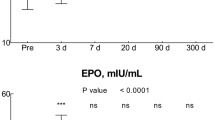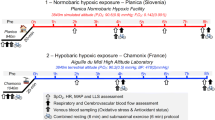Abstract
Purpose
This single-blind, repeated measures study evaluated adaptive and maladaptive responses to continuous and intermittent hypoxic patterns in young adults.
Methods
Changes in haematological profile, stress and cardiac damage were measured in ten healthy young participants during three phases: (1) breathing normoxic air (baseline); (2) breathing normoxic air via a mask (Sham-controls); (3) breathing intermittent hypoxia (IH) via a mask, mean peripheral oxygen saturation (SpO2) of 85% ~ 70 min of hypoxia. After a 5-month washout period, participants repeated this three-phase protocol with phase, (4) consisting of continuous hypoxia (CH), mean SpO2 = 85%, ~ 70 min of hypoxia. Measures of the red blood cell count (RBCc), haemoglobin concentration ([Hb]), haematocrit (Hct), percentage of reticulocytes (% Retics), secretory immunoglobulin A (S-IgA), cortisol, cardiac troponin T (cTnT) and the erythropoietic stimulation index (calculated OFF-score) were compared across treatments.
Results
Despite identical hypoxic durations at the same fixed SpO2, no significant effects were observed in either CH or Sham-CH control, compared to baseline. While IH and Sham-IH controls demonstrated significant increases in: RBCc; [Hb]; Hct; and the erythropoietic stimulation index. Notably, the % Retics decreased significantly in response to IH (-31.9%) or Sham-IH control (-23.6%), highlighting the importance of including Sham-controls. No difference was observed in S-IgA, cortisol or cTnT.
Conclusion
The IH but not CH pattern significantly increased key adaptive haematological responses, without maladaptive increases in S-IgA, cortisol or cTnT, indicating that the IH hypoxic pattern would be the best method to boost haematological profiles prior to ascent to altitude.





Similar content being viewed by others
Abbreviations
- % Retics :
-
Percentage of reticulocytes
- CH :
-
Continuous hypoxia
- cTnT :
-
Cardiac troponin T
- EPO :
-
Erythropoietin
- FiO 2 :
-
Fraction of inspired oxygen
- Hct :
-
Haematocrit
- [Hb] :
-
Haemoglobin concentration
- HIF :
-
Hypoxia inducible factors
- IH :
-
Intermittent hypoxia
- OFF-score :
-
Erythropoietic stimulation index
- PiO 2 :
-
Inspired oxygen partial pressure
- RBC c :
-
Red blood cell count
- S-IgA :
-
Secretory immunoglobulin A
- SpO 2 :
-
Peripheral oxygen saturation
References
Brugniaux JV, Pialoux V, Foster GE, Duggan CT, Eliasziw M, Hanly PJ, Poulin MJ (2011) Effects of intermittent hypoxia on erythropoietin, soluble erythropoietin receptor and ventilation in humans. Eur Respir J 37(4):880–887
Burtscher M, Mairer K, Wille M, Gatterer H, Ruedl G, Faulhaber M, Sumann G (2012) Short-term exposure to hypoxia for work and leisure activities in health and disease: which level of hypoxia is safe? Sleep Breath 16(2):435–442
Butcher SJ, Jones RL, Eves ND, Petersen SR (2006) Work of breathing is increased during exercise with the self-contained breathing apparatus regulator. Appl Physiol Nutr Metab 31(6):693–701
Costalat G, Lemaitre F, Tobin B, Renshaw G (2017) Intermittent hypoxia revisited: a promising non-pharmaceutical strategy to reduce cardio-metabolic risk factors? Sleep Breath 2(10):017–1459
Dill DB, Costill DL (1974) Calculation of percentage changes in volumes of blood, plasma, and red cells in dehydration. J Appl Physiol 37(2):247–248
Dubois AB, Botelho SY, Comroe JH Jr (1956) A new method for measuring airway resistance in man using a body plethysmograph: values in normal subjects and in patients with respiratory disease. J Clin Investig 35(3):327–335. https://doi.org/10.1172/jci103282
Dunham-Snary KJ, Wu D, Sykes EA, Thakrar A, Parlow LRG, Mewburn JD, Parlow JL, Archer SL (2017) Hypoxic pulmonary vasoconstriction: from molecular mechanisms to medicine. Chest 151(1):181–192
Faulhaber M, Wille M, Gatterer H, Heinrich D, Burtscher M (2014) Resting arterial oxygen saturation and breathing frequency as predictors for acute mountain sickness development: a prospective cohort study. Sleep Breath 17:17
Faulhaber M, Pocecco E, Gatterer H, Niedermeier M, Huth M, Dünnwald T, Menz V, Bernardi L, Burtscher M (2016) Seven passive 1-h hypoxia exposures do not prevent AMS in susceptible individuals. Med Sci Sports Exerc 48(12):2563–2570
Foster GE, McKenzie DC, Milsom WK, Sheel AW (2005) Effects of two protocols of intermittent hypoxia on human ventilatory, cardiovascular and cerebral responses to hypoxia. J Physiol 567(Pt 2):689–699
Fulco CS, Rock PB, Cymerman A (1998) Maximal and submaximal exercise performance at altitude. Aviat Space Environ Med 69(8):793–801
Fulco CS, Muza SR, Beidleman BA, Demes R, Staab JE, Jones JE, Cymerman A (2011) Effect of repeated normobaric hypoxia exposures during sleep on acute mountain sickness, exercise performance, and sleep during exposure to terrestrial altitude. Am J Physiol Regul Integr Comp Physiol 300(2):1
Fulco CS, Beidleman BA, Muza SR (2013) Effectiveness of preacclimatization strategies for high-altitude exposure. Exerc Sport Sci Rev 41(1):55–63
Gore CJ, Parisotto R, Ashenden MJ, Stray-Gundersen J, Sharpe K, Hopkins W, Emslie KR, Howe C, Trout GJ, Kazlauskas R, Hahn AG (2003) Second-generation blood tests to detect erythropoietin abuse by athletes. Haematologica 88(3):333–344
Jelkmann W (2011) Regulation of erythropoietin production. J Physiol 589(Pt 6):1251–1258
Kim TS, Hanak M, Trampont PC, Braciale TJ (2015) Stress-associated erythropoiesis initiation is regulated by type 1 conventional dendritic cells. J Clin Investig 125(10):3965–3980
Koehle MS, Sheel AW, Milsom WK, McKenzie DC (2007) Two patterns of daily hypoxic exposure and their effects on measures of chemosensitivity in humans. J Appl Physiol 103(6):1973–1978
Koistinen PO, Rusko H, Irjala K, Rajamäki A, Penttinen K, Sarparanta VP, Karpakka J, Leppäluoto J (2000) EPO, red cells, and serum transferrin receptor in continuous and intermittent hypoxia. Med Sci Sports Exerc 32(4):800–804. https://doi.org/10.1097/00005768-200004000-00012
Lobigs LM, Sharpe K, Garvican-Lewis LA, Gore CJ, Peeling P, Dawson B, Schumacher YO (2017) The athlete’s hematological response to hypoxia: a meta-analysis on the influence of altitude exposure on key biomarkers of erythropoiesis. Am J Hematol 93(1):74–83. https://doi.org/10.1002/ajh.24941
Luks AM, Auerbach PS, Freer L, Grissom CK, Keyes LE, McIntosh SE, Rodway GW, Schoene RB, Zafren K, Hackett PH (2019) Wilderness Medical Society Clinical Practice Guidelines for the Prevention and Treatment of Acute Altitude Illness: 2019 Update. Wilderness Environ Med 30(4, supplement):S3–S18. https://doi.org/10.1016/j.wem.2019.04.006
Luks AM, Swenson ER, Bärtsch P (2017) Acute high-altitude sickness. Eur Respir Rev 26(143)
Mallet RT, Manukhina EB, Ruelas SS, Caffrey JL, Downey HF (2018) Cardioprotection by intermittent hypoxia conditioning: evidence, mechanisms, and therapeutic potential. Am J Physiol Heart Circ Physiol 315(2):H216–H232
McCambridge J, Witton J, Elbourne DR (2014) Systematic review of the Hawthorne effect: new concepts are needed to study research participation effects. J Clin Epidemiol 67(3):267–277. https://doi.org/10.1016/j.jclinepi.2013.08.015
Michiels C, Tellier C, Feron O (2016) Cycling hypoxia: a key feature of the tumor microenvironment. Biochim Biophys Acta Rev Cancer 1866(1):76–86. https://doi.org/10.1016/j.bbcan.2016.06.004
Millet GP, Brocherie F (2020) Hypoxic training is beneficial in elite athletes. Med Sci Sports Exerc 52(2):515–518
Millet GP, Brocherie F, Girard O, Wehrlin JP, Troesch S, Hauser A, Steiner T, Peltonen JE, Rusko HK, Constantini K, Fulton TJ, Hursh DG, Noble TJ, Paris HL, Wiggins CC, Chapman RF, Levine BD, Kumar VH, Schmidt WF (2016) Commentaries on Viewpoint: Time for a new metric for hypoxic dose? J Appl Physiol (1985) 121(1):356–358. https://doi.org/10.1152/japplphysiol.00460.2016
Muangritdech N, Hamlin MJ, Sawanyawisuth K, Prajumwongs P, Saengjan W, Wonnabussapawich P, Manimmanakorn N, Manimmanakorn A (2020) Hypoxic training improves blood pressure, nitric oxide and hypoxia-inducible factor-1 alpha in hypertensive patients. Eur J Appl Physiol 120(8):1815–1826. https://doi.org/10.1007/s00421-020-04410-9
Ovchynnikova E, Aglialoro F, von Lindern M, van den Akker E (2018) The shape shifting story of reticulocyte maturation. Front Physiol 9:829–829. https://doi.org/10.3389/fphys.2018.00829
Patrician A, Dujić Ž, Spajić B, Drviš I, Ainslie PN (2021) Breath-hold diving-the physiology of diving deep and returning. Front Physiol. https://doi.org/10.3389/fphys.2021.639377
Pichon AP, Connes P, Robach P (2016) Effects of acute and chronic hematocrit modulations on blood viscosity in endurance athletes. Clin Hemorheol Microcirc 64(2):115–123
Pla R, Brocherie F, Le Garrec S, Richalet J-P (2020) Effectiveness of the hypoxic exercise test to predict altitude illness and performance at moderate altitude in high-level swimmers. Physiol Rep 8(8):e14390. https://doi.org/10.14814/phy2.14390
Pohunek P (2021) Physiology of the Airways. In: Goldfarb S, Piccione J (eds) Diagnostic and interventional bronchoscopy in children. Springer International Publishing, Cham, pp 45–50. https://doi.org/10.1007/978-3-030-54924-4_5
Richalet J-P, Canoui-Poitrine F (2014) Pro: Hypoxic cardiopulmonary exercise testing identifies subjects at risk for severe high altitude illnesses. High Alt Med Biol 15(3):315–317
Rodriguez FA, Ventura JL, Casas M, Casas H, Pages T, Rama R, Ricart A, Palacios L, Viscor G (2000) Erythropoietin acute reaction and haematological adaptations to short, intermittent hypobaric hypoxia. Eur J Appl Physiol 82(3):170–177
Schnoder TM, Arreba-Tutusaus P, Griehl I, Bullinger L, Buschbeck M, Lane SW, Dohner K, Plass C, Lipka DB, Heidel FH, Fischer T (2015) Epo-induced erythroid maturation is dependent on Plcgamma1 signaling. Cell Death Differ 22(6):974–985
Semenza GL (2019) Pharmacologic targeting of hypoxia-inducible factors. Annu Rev Pharmacol Toxicol 59(1):379–403. https://doi.org/10.1146/annurev-pharmtox-010818-021637
Serebrovskaya TV, Nosar VI, Bratus LV, Gavenauskas BL, Mankovska IM (2013) Tissue oxygenation and mitochondrial respiration under different modes of intermittent hypoxia. High Alt Med Biol 14(3):280–288
Siebenmann C, Dempsey JA (2020) Hypoxic training is not beneficial in elite athletes. Med Sci Sports Exerc 52(2):519–522
Tobin B, Costalat G, Renshaw GMC (2020) Intermittent not continuous hypoxia provoked haematological adaptations in healthy seniors: hypoxic pattern may hold the key. Eur J Appl Physiol 120(3):707–718
Treml B, Kleinsasser A, Hell T, Knotzer H, Wille M, Burtscher M (2020) Carry-over quality of pre-acclimatization to altitude elicited by intermittent hypoxia: a participant-blinded, randomized controlled trial on antedated acclimatization to altitude. Front Physiol 11:531
Verges S, Chacaroun S, Godin-Ribuot D, Baillieul S (2015) Hypoxic conditioning as a new therapeutic modality. Front Pediatr. https://doi.org/10.3389/fped.2015.00058
Viscor G, Torrella JR, Corral L, Ricart A, Javierre C, Pages T, Ventura JL (2018) Physiological and biological responses to short-term intermittent hypobaric hypoxia exposure: from sports and mountain medicine to new biomedical applications. Front Physiol 9:814–814. https://doi.org/10.3389/fphys.2018.00814
Wang JS, Chen LY, Fu LL, Chen ML, Wong MK (2007) Effects of moderate and severe intermittent hypoxia on vascular endothelial function and haemodynamic control in sedentary men. Eur J Appl Physiol 100(2):127–135
Wehrlin JP, Marti B, Hallén J (2016) Hemoglobin mass and aerobic performance at moderate altitude in elite athletes. Adv Exp Med Biol 903:357–374. https://doi.org/10.1007/978-1-4899-7678-9_24
West J, Schoene R, Luks A, Milledge J (2012) High altitude medicine and physiology 5E. CRC Press, Boca Raton
Wille M, Gatterer H, Mairer K, Philippe M, Schwarzenbacher H, Faulhaber M, Burtscher M (2012) Short-term intermittent hypoxia reduces the severity of acute mountain sickness. Scand J Med Sci Sports 22(5):1600–1838
Wojan F, Stray-Gundersen S, Nagel MJ, Lalande S (2021) Short exposure to intermittent hypoxia increases erythropoietin levels in healthy individuals. J Appl Physiol 130(6):1955–1960. https://doi.org/10.1152/japplphysiol.00941.2020
Acknowledgements
The authors would like to thank Biomedtech Australia Pty. Ltd., the Heart Foundation Research Centre Griffith University and the Griffith Health Institute for generously supporting this independent investigation. We greatly appreciated the opportunity to borrow hypoxicators from Oleg Bassovitch, GO2Altitude®. We are grateful to the participants for their enthusiastic involvement in this study, to Taryn Mann for quantifying troponin T and to Dr. Mike Steele for statistical advice as well as to Dr. Glenn Harrison for insightful comments on early drafts of this manuscript.
Author information
Authors and Affiliations
Corresponding author
Ethics declarations
Conflict of interest
The authors declare that there was no conflict of interest and that the results of the present study do not constitute endorsement of any specific brand of equipment for hypoxia delivery.
Additional information
Communicated by Guido Ferretti.
Publisher's Note
Springer Nature remains neutral with regard to jurisdictional claims in published maps and institutional affiliations.
Rights and permissions
About this article
Cite this article
Tobin, B., Costalat, G. & Renshaw, G.M.C. Pre-acclimation to altitude in young adults: choosing a hypoxic pattern at sea level which provokes significant haematological adaptations. Eur J Appl Physiol 122, 395–407 (2022). https://doi.org/10.1007/s00421-021-04837-8
Received:
Accepted:
Published:
Issue Date:
DOI: https://doi.org/10.1007/s00421-021-04837-8




